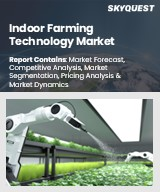
|
시장보고서
상품코드
1481337
수경재배 시장 : 시스템별, 작물별, 지역별, 농법별, 기기별 및 예측( 2024-2032년)Hydroponics Market - By Systems, By Crops, By Area, By Farming Method, By Equipment & Forecast, 2024 - 2032 |
||||||
세계의 수경재배 시장은 지속가능 농업과 식량안보의 촉진을 목적으로 한 정부 프로젝트 및 구상에 의해 2024-2032년 8.5% 이상의 CAGR을 보일 것으로 생각됩니다.
세계 각국 정부는 물 부족, 토지 제한, 기후 변화가 기존 농업에 미치는 영향 등의 문제를 해결하기 위한 해결책으로 수경재배에 투자하고 있습니다.
예를 들어 2023년 12월 Uttarakhand Rural Development and Panchayati Raj Institute는 원예부가 지원하는 혁신적인 수경재배를 도입할 준비를 하고 있다고 발표했습니다. UIRD는 지구 계획에서 할당된 95만 루피의 예산으로 수경 재배를위한 최첨단 폴리 하우스를 건설했습니다.
이러한 노력에는 연구개발에 대한 자금 지원, 수경재배 인프라 구축에 대한 보조금 지원, 농가을 위한 교육 프로그램 등이 포함됩니다. 또한 민관 파트너십을 통해 수경재배 분야의 기술 혁신과 기술 발전을 촉진하고 있습니다. 정부가 지속가능한 식량 생산을 우선시하고 전통 농업에 대한 의존도를 줄이려는 노력으로 수경재배 시스템과 솔루션에 대한 수요는 계속 증가하고 있으며, 이는 시장 확대와 개척을 촉진하고 있습니다.
액체 시스템 분야는 2032년까지 큰 성장을 기록할 것으로 보입니다. 영양필름법(NFT) 및 심층수 배양법(DWC)과 같은 액체 시스템은 식물에 대한 영양 공급을 정확하게 제어할 수 있으며, 성장을 가속화하고 수확량을 증가시킬 수 있습니다. 이러한 시스템은 수성 영양 용액을 사용하여 식물에 직접 영양을 공급하기 때문에 토양이 필요하지 않아 기존 농법에 비해 물 소비를 줄일 수 있습니다. 또한 액체 시스템은 다양한 유형의 작물과 재배 환경에 적합한 다목적성을 가지고 있습니다. 농업 부문이 자원 제약과 환경 문제를 해결하기 위한 혁신적인 해결책을 모색하는 가운데, 수경재배 시장에서 액체 수경재배 시스템에 대한 수요는 꾸준히 증가하고 있습니다.
2023-2032년 양상추 부문이 수경재배 시장 성장에 있으며, 압도적인 점유율을 차지할 것으로 예상됩니다. 양상추는 수경 재배 시스템에서 자라며, 이러한 설정이 제공하는 영양 공급과 최적의 성장 조건을 정확하게 제어할 수 있는 이점을 누리고 있습니다. 수경재배는 기존의 토경재배에 비해 빠른 성장 속도, 높은 수확량, 적은 물 사용량 등 많은 이점을 가지고 있습니다. 또한 수경재배 상추는 우수한 품질, 신선도, 유통기한이 길어 소비자와 상업적 생산자 모두에게 선호되는 선택이 되고 있습니다. 신선하고 지속가능한 농산물에 대한 수요가 지속적으로 증가함에 따라 수경 양상추 재배는 수경 재배 시장에서 이러한 수요를 충족시키는 데 매우 중요한 역할을 하고 있습니다.
유럽 수경재배 시장은 2024-2032년 상당한 CAGR을 보일 것으로 예상됩니다. 지속가능한 농업과 식량안보에 대한 관심이 높아지면서 수경재배 시스템은 효율적인 작물 재배를 위한 실행 가능한 솔루션을 제공합니다. 유럽 국가들은 한정된 경작지와 물 부족이라는 문제에 직면해 있으며, 수경재배가 매력적인 대안으로 떠오르고 있습니다. 또한 현지의 신선한 농산물에 대한 수요가 증가하면서 소비자와 상업적 재배자들 사이에서 수경재배를 채택하는 추세입니다.
혁신적인 농법을 지원하는 정부의 구상은 시장 성장을 더욱 촉진할 것입니다.
유럽은 환경에 미치는 영향을 최소화하면서 농업 생산성을 향상시키는 것을 목표로 하고 있으므로 수경재배 시장은 안정적인 수요를 가지고 있으며, 유럽은 세계 수경재배 산업의 주요 기업으로 자리매김하고 있습니다. 예를 들어 2023년 12월 스웨덴 린셰핑 대학교 연구실은 농업 기술에서 선구적인 진전을 이루었습니다. 연구진은 작물의 놀라운 성장을 가속하도록 설계된 전도성 "토양"을 발표했습니다. 수경재배로 알려진 이 획기적인 농법은 기존의 토양을 배제하고 독특한 재배 기질을 사용하여 고도로 발달된 뿌리 시스템을 활성화합니다.
목차
제1장 조사 방법과 조사 범위
제2장 주요 요약
제3장 업계 인사이트
- 업계 에코시스템 분석
- 공급업체 상황
- 제조업체·공급업체
- 테크놀러지 프로바이더
- 시스템 통합사업자
- 판매업체
- 최종사용자
- 이익률 분석
- 기술과 혁신 전망
- 특허 분석
- 주요 뉴스·구상
- 규제 상황
- 영향요인
- 성장 촉진요인
- 업계의 잠재적 리스크 & 과제
- 성장 가능성 분석
- Porter의 산업 분석
- PESTEL 분석
제4장 경쟁 구도
- 서론
- 기업 시장 점유율 분석
- 경쟁 포지셔닝·매트릭스
- 전략 전망 매트릭스
제5장 시장 추산·예측 : 시스템별, 2018-2032년
- 주요 동향
- 애그리게이트 시스템
- EBB & 플로우 시스템
- 드립 시스템
- 위크 시스템
- 리키드 시스템
- 심층수 배양
- NFT(Nutrient film technique)
- 에어로포닉스
제6장 시장 추산·예측 : 작물별, 2018-2032년
- 주요 동향
- 토마토
- 양상추
- 피망
- 오이
- 허브
- 기타
제7장 시장 추산·예측 : 지역별, 2018-2032년
- 주요 동향
- 1,000평방피트 이하
- 1,000-50,000평방피트
- 50,000평방피트 이상
제8장 시장 추산·예측 : 농법별, 2018-2032년
- 주요 동향
- 실내
- 야외
제9장 시장 추산·예측 : 기기별, 2018-2032년
- 주요 동향
- 공조
- LED 재배 조명
- 제어 시스템
- 관개 시스템
- 자재관리 기기
- 기타
제10장 시장 추산·예측 : 지역별, 2018-2032년
- 주요 동향
- 북미
- 미국
- 캐나다
- 유럽
- 영국
- 독일
- 프랑스
- 이탈리아
- 스페인
- 러시아
- 북유럽
- 기타 유럽
- 아시아태평양
- 중국
- 인도
- 일본
- 한국
- 호주
- 동남아시아
- 기타 아시아태평양
- 라틴아메리카
- 브라질
- 멕시코
- 아르헨티나
- 기타 라틴아메리카
- 중동 및 아프리카
- 남아프리카공화국
- 사우디아라비아
- 아랍에미리트
- 기타 중동 및 아프리카
제11장 기업 개요
- AeroFarms
- AmHydro
- AppHarvest, Inc.
- Argus Control Systems Limited
- Back to the Roots
- BrightFarms
- Circulus Agtech
- CityCrop
- Emirates Hydroponics Farms
- Freight Farms, Inc.
- GrowPura
- Heliospectra
- Hydrofarm
- iBio
- Infarm
- Lettus Grow
- Nutrifresh
- Sentek
- Signify Holding
- UrbanKisaan
Global Hydroponics Market will witness over 8.5% CAGR between 2024 and 2032, driven by government projects and initiatives aimed at promoting sustainable agriculture and food security. Governments worldwide are investing in hydroponic farming methods as a solution to address challenges such as water scarcity, land limitations, and climate change impacts on traditional agriculture.
For instance, in December 2023, The Uttarakhand Rural Development and Panchayati Raj Institute announced that it is preparing to introduce an innovative hydroponic farming initiative backed by the Department of Horticulture. With a budget of Rs 9.5 lakh allocated from the district scheme, UIRD constructed a state-of-the-art polyhouse for water-based cultivation.
These initiatives involve funding research and development, providing subsidies for hydroponic infrastructure setup, and offering training programs for farmers. Moreover, public-private partnerships are fostering innovation and technological advancements in the hydroponics sector. As governments prioritize sustainable food production and seek to reduce reliance on traditional farming practices, the demand for hydroponic systems and solutions continues to grow, propelling market expansion and development.
The overall Hydroponics Industry size is classified based on the systems, crops, area, farming method, and region.
The liquid systems segment will register significant growth through 2032. Liquid systems, such as nutrient film technique (NFT) and deep water culture (DWC), enable precise control over nutrient delivery to plants, resulting in accelerated growth and higher yields. These systems utilize water-based nutrient solutions to nourish plants directly, eliminating the need for soil and reducing water consumption compared to traditional farming methods. Additionally, liquid systems offer versatility, making them suitable for various crop types and cultivation environments. As the agricultural sector seeks innovative solutions to address resource constraints and environmental challenges, the demand for liquid hydroponic systems continues to rise steadily in the Hydroponics Market.
The hydroponics market growth from the lettuce segment will capture a dominant share from 2023 to 2032. Lettuce thrives in hydroponic systems, benefiting from the precise control over nutrient delivery and optimal growing conditions provided by these setups. Hydroponic lettuce cultivation offers numerous advantages, including faster growth rates, higher yields, and reduced water usage compared to traditional soil-based methods. Additionally, hydroponic lettuce is known for its superior quality, freshness, and extended shelf life, making it a preferred choice for consumers and commercial growers alike. As the demand for fresh and sustainable produce continues to rise, hydroponic lettuce cultivation plays a pivotal role in meeting this demand in the Hydroponics Market.
Europe hydroponics market will showcase a commendable CAGR from 2024 to 2032. With a growing emphasis on sustainable agriculture and food security, hydroponic systems offer a viable solution for efficient crop cultivation. European countries face challenges such as limited arable land and water scarcity, making hydroponics an attractive alternative. Additionally, the rising demand for fresh, locally grown produce drives adoption among consumers and commercial growers.
Government initiatives supporting innovative farming methods further stimulate market growth.
As Europe seeks to enhance agricultural productivity while minimizing environmental impact, the Hydroponics Market experiences steady demand, positioning the region as a key player in the global hydroponics industry. For instance, in December 2023, the laboratories of Linkoping University in Sweden made a pioneering advancement in agricultural technology. Researchers introduced an electrically conductive "soil" designed to promote remarkable crop growth. This groundbreaking approach to cultivation, known as hydroponics, eliminated traditional soil and utilized a unique cultivation substrate to activate an advanced root system.
Table of Contents
Chapter 1 Methodology & Scope
- 1.1 Market scope & definitions
- 1.2 Base estimates & calculations
- 1.3 Forecast calculations
- 1.4 Data sources
- 1.4.1 Primary
- 1.4.2 Secondary
- 1.4.2.1 Paid sources
- 1.4.2.2 Public sources
Chapter 2 Executive Summary
- 2.1 Industry 360 degree synopsis, 2018 - 2032
Chapter 3 Industry Insights
- 3.1 Industry ecosystem analysis
- 3.2 Supplier landscape
- 3.2.1 Manufacturers & suppliers
- 3.2.2 Technology providers
- 3.2.3 System integrators
- 3.2.4 Distributors
- 3.2.5 End-users
- 3.3 Profit margin analysis
- 3.4 Technology & innovation landscape
- 3.5 Patent analysis
- 3.6 Key news & initiatives
- 3.7 Regulatory landscape
- 3.8 Impact forces
- 3.8.1 Growth drivers
- 3.8.1.1 Increasing demand for locally sourced, fresh produce
- 3.8.1.2 Expansion of vertical farming in urban areas
- 3.8.1.3 Growing awareness of sustainable agriculture practices
- 3.8.1.4 Government support for hydroponic farming initiatives
- 3.8.2 Industry pitfalls & challenges
- 3.8.2.1 High initial investment costs for hydroponic setups
- 3.8.2.2 Limited crop variety compared to traditional farming
- 3.8.1 Growth drivers
- 3.9 Growth potential analysis
- 3.10 Porter's analysis
- 3.10.1 Supplier power
- 3.10.2 Buyer power
- 3.10.3 Threat of new entrants
- 3.10.4 Threat of substitutes
- 3.10.5 Industry rivalry
- 3.11 PESTEL analysis
Chapter 4 Competitive Landscape, 2023
- 4.1 Introduction
- 4.2 Company market share analysis
- 4.3 Competitive positioning matrix
- 4.4 Strategic outlook matrix
Chapter 5 Market Estimates & Forecast, By Systems, 2018 - 2032 ($Bn)
- 5.1 Key trends
- 5.2 Aggregate systems
- 5.2.1 EBB & flow systems
- 5.2.2 Drip systems
- 5.2.3 Wick systems
- 5.3 Liquid systems
- 5.3.1 Deep water culture
- 5.3.2 Nutrient film technique (NFT)
- 5.3.3 Aeroponics
Chapter 6 Market Estimates & Forecast, By Crops, 2018 - 2032 ($Bn)
- 6.1 Key trends
- 6.2 Tomatoes
- 6.3 Lettuce
- 6.4 Peppers
- 6.5 Cucumbers
- 6.6 Herbs
- 6.7 Others
Chapter 7 Market Estimates & Forecast, By Area, 2018 - 2032 ($Bn)
- 7.1 Key trends
- 7.2 Up to 1,000 sq. ft.
- 7.3 1,000-50,000 sq. ft.
- 7.4 Above 50,000 sq. ft
Chapter 8 Market Estimates & Forecast, By Farming Method, 2018 - 2032 ($Bn)
- 8.1 Key trends
- 8.2 Indoor
- 8.3 Outdoor
Chapter 9 Market Estimates & Forecast, By Equipment, 2018 - 2032 ($Bn)
- 9.1 Key trends
- 9.2 HVAC
- 9.3 LED grow lights
- 9.4 Control systems
- 9.5 Irrigation systems
- 9.6 Material handling equipment
- 9.7 Others
Chapter 10 Market Estimates & Forecast, By Region, 2018 - 2032 ($Bn)
- 10.1 Key trends
- 10.2 North America
- 10.2.1 U.S.
- 10.2.2 Canada
- 10.3 Europe
- 10.3.1 UK
- 10.3.2 Germany
- 10.3.3 France
- 10.3.4 Italy
- 10.3.5 Spain
- 10.3.6 Russia
- 10.3.7 Nordics
- 10.3.8 Rest of Europe
- 10.4 Asia Pacific
- 10.4.1 China
- 10.4.2 India
- 10.4.3 Japan
- 10.4.4 South Korea
- 10.4.5 Australia
- 10.4.6 Southeast Asia
- 10.4.7 Rest of Asia Pacific
- 10.5 Latin America
- 10.5.1 Brazil
- 10.5.2 Mexico
- 10.5.3 Argentina
- 10.5.4 Rest of Latin America
- 10.6 MEA
- 10.6.1 South Africa
- 10.6.2 Saudi Arabia
- 10.6.3 UAE
- 10.6.4 Rest of MEA
Chapter 11 Company Profiles
- 11.1 AeroFarms
- 11.2 AmHydro
- 11.3 AppHarvest, Inc.
- 11.4 Argus Control Systems Limited
- 11.5 Back to the Roots
- 11.6 BrightFarms
- 11.7 Circulus Agtech
- 11.8 CityCrop
- 11.9 Emirates Hydroponics Farms
- 11.10 Freight Farms, Inc.
- 11.11 GrowPura
- 11.12 Heliospectra
- 11.13 Hydrofarm
- 11.14 iBio
- 11.15 Infarm
- 11.16 Lettus Grow
- 11.17 Nutrifresh
- 11.18 Sentek
- 11.19 Signify Holding
- 11.20 UrbanKisaan



















